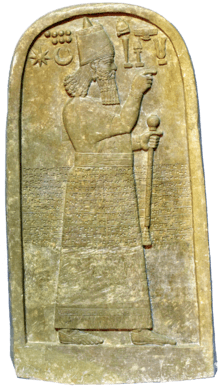Yangi
Yangi (Akkadian: 𒅀𒀭𒄀, romanized: Ia-an-gi) was an early monarch of the Early Period of Assyria (Azuhinum). He is listed as the third among the “seventeen kings who lived in tents” within the Mesopotamian Chronicles.[1][2] Yangi was preceded by Adamu, and succeeded by Suhlamu. Next to nothing is otherwise known about Yangi's reign.
| Yangi | |
|---|---|
| Monarch of Azuhinum | |
| Reign | fl. c. 2375 BCE — c. 2350 BCE |
| Predecessor | Adamu |
| Successor | Suhlamu |
Geopolitical context
Yangi is succeeded on the Assyrian King List by Suhlamu and then a further thirteen rulers: Harharu, Mandaru, Imsu, Harsu, Didanu, Hana, Zuabu, Nuabu, Abazu, Belu Azarah, Ushpia and Apiashal. Nothing concrete is yet known about these names, although it has been noted that a much later Babylonian tablet listing the ancestral lineage of Hammurabi of Babylon, seems to have copied the same names from Tudiya through Nuabu, though in a heavily corrupted form. The earliest Assyrian kings (such as Tudiya), who are recorded as, “kings who lived in tents,” had at first been independent semi-nomadic pastoralist rulers, moreover; Assyria was originally an oligarchy rather than a monarchy. These kings had at some point become fully urbanized and founded the city-state of Assur.[3]
Both Assyria and Sumer had become subject to the Akkadian Empire, centered in central Mesopotamia c. 2400 BC. The Akkadian Empire claimed to encompass the surrounding, “four corners of the world.” Assyrian rulers had become subject to Sargon of Akkad and his successors, and the city-state of Assur had become a regional administrative center of the Empire, implicated by the Nuzi tablets.[4]
The region of Assyria, north of the seat of the empire in central Mesopotamia, had been known as Azuhinum in Akkadian records.[5] Towards the end of the reign of Sargon the Akkad, the Assyrian faction had rebelled against him; “the tribes of Assyria of the upper country—in their turn attacked, but they submitted to his arms, and Sargon settled their habitations, and he smote them grievously.”[6]
| Preceded by Adamu |
Monarch of Azuhinum fl. c. 2375 BCE — c. 2350 BCE |
Succeeded by Suhlamu |
References
- Glassner, Jean-Jacques (2004). Mesopotamian Chronicles. Society of Biblical Lit. p. 137. ISBN 978-1-58983-090-5.
- Ebeling, Erich; Meissner, Bruno; Weidner, Ernst Friedrich (1928). Reallexikon D Assyriologie Bd 6 Cplt Geb **. W. de Gruyter. p. 103. ISBN 978-3-11-010051-8.
- Saggs, The Might, 24.
- Malati J. Shendge (1 January 1997). The language of the Harappans: from Akkadian to Sanskrit. Abhinav Publications. p. 46. ISBN 978-81-7017-325-0. Retrieved 22 April 2011.
- "Prehistory and Protohistory of the Arabian Peninsula: Bahrain". M. A. Nayeem. 1990. p. 32.
- Malati J. Shendge (1 January 1997). The language of the Harappans: from Akkadian to Sanskrit. Abhinav Publications. p. 46. ISBN 978-81-7017-325-0. Retrieved 22 April 2011.
